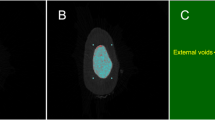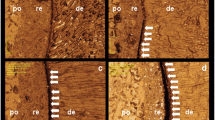Abstract
The purposes of the study were to evaluate the bond strength of bioceramic TotalFill root repair material (RRM) in retrograde cavities prepared using Er:YAG and Er,Cr:YSGG laser and steel bur, and to analyze failure modes. The root canals of 30 single-rooted teeth were endodontically treated, their root-ends were resected using a diamond bur, and the teeth were randomly divided into three groups (N = 10) according to the retrograde cavity preparation technique: (1) Er:YAG laser, (2) Er,Cr:YSGG laser, and (3) steel bur. All retrograde cavities were filled with the TotalFill RRM which was prepared according to the manufacturers’ instructions. Push-out test was performed using universal testing machine, and failure mode was analyzed using a scanning electron microscope. The data were analyzed using one-way ANOVA, post hoc analysis with Bonferroni correction, and Fisher-Freeman-Halton exact test (p < 0.05). In the Er:YAG-, Er,Cr:YSGG-, and steel bur–prepared cavities, mean bond strengths (MPa) were 12.76, 8.44, and 6.01, respectively. The bond strength of the TotalFill RRM to dentin was significantly higher in the Er:YAG laser compared with the steel bur–prepared cavities (p = 0.004). The bond strength was not significantly different between the Er:YAG and Er,Cr:YSGG cavities (p = 0.074) and between the Er,Cr:YSGG and bur cavities (p = 0.648). In the cavities prepared by the Er,Cr:YSGG laser and bur, the failure mode of the TotalFill RRM was predominantly mixed, then adhesive and cohesive. In the Er:YAG laser–prepared cavities, the most common failure mode was adhesive, followed by mixed type and no cohesive failure. The bond strength of the TotalFill RRM to dentin was highest in the group of retrograde cavities prepared by the Er:YAG laser.



Similar content being viewed by others
References
Briggs PF, Scott BJ (1997) Evidence-based dentistry: endodontic failure-how should it be managed? Br Dent J 183:159–164
Martí Bowen E, Peñarrocha M (2006) An update in periapical surgery. Med Oral Patol Oral Cir Bucal 11:E503–E509
Wallace JA (2006) Effect of Waterlase laser retrograde root-end cavity preparation on the integrity of root apices of extracted teeth as demonstrated by light microscopy. Aust Endod J 32:35–39
Rainwater A, Jeansonne BG, Sarkaro N (2000) Effects of ultrasonic root-end preparation on micro-crack formation and leakage. J Endod 26:72–75
Kimura Y, Wilder-Smith P, Matsumoto K (2000) Lasers in endodontics: a review. Int Endod J 33:173–185
Komori T, Yokoyama K, Takato T, Matsumoto K (1997) Clinical application of the erbium: YAG laser for apicoectomy. J Endod 23:748–750
van As G (2004) Erbium lasers in dentistry. Dent Clin N Am 48:1017–1059
Karlovic Z, Pezelj-Ribaric S, Miletic I, Jukic S, Grgurevic J, Anic I (2005) Erbium: YAG laser versus ultrasonic in preparation of root-end cavities. J Endod 31:821–823
Rahimi S, Yavari HR, Shahi S, Zand V, Shakoui S, Reyhani MF, Pirzadeh A (2010) Comparison of the effect of Er,Cr-YSGG laser and ultrasonic retrograde root-end cavity preparation on the integrity of root apices. J Oral Sci 52:77–81
Angiero F, Benedicenti S, Signore A, Parker S, Crippa R (2011) Apicoectomies with the erbium laser: a complementary technique for retrograde endodontic treatment. Photomed Laser Surg 29:845–849
Gartner AH, Dorn SO (1992) Advances in endodontic surgery. Dent Clin N Am 36:357–378
Torabinejad M, Higa RK, McKendry DJ, Pitt Ford TR (1994) Dye leakage of four root end filling materials: effects of blood contamination. J Endod 20:159–163
Parirokh M, Torabinejad M (2010) Mineral trioxide aggregate: a comprehensive literature review– part I: chemical, physical and antibacterial properties. J Endod 36:16–27
Damas BA, Wheater MA, Bringas JS, Hoen MM (2011) Cytotoxicity comparison of mineral trioxide aggregates and EndoSequence bioceramic root repair materials. J Endod 37:372–375
Lukac N, Suhovršnik T, LukaČ M, Jezeršeka M (2016) Ablation characteristics of quantum square pulse mode dental erbium laser. J Biomed Opt 21:015012
Shokouhinejad N, Nekoofar MH, Razmi H, Sajadi S, Davies TE, Saghiri MA, Gorjestani H, Dummer PM (2012) Bioactivity of EndoSequence root repair material and bioaggregate. Int Endod J 45:1127–1134
Antunes HS, Gominho LF, Andrade-Junior CV, Dessaune-Neto N, Alves FR, Rôças IN, Siqueira JF Jr (2016) Sealing ability of two root-end filling materials in a bacterial nutrient leakage model. Int Endod J 49:960–965
Kadić S, Baraba A, Miletić I, Ionescu A, Brambilla E, Ivanišević Malčić A, Gabrić D (2018) Push-out bond strength of three different calcium silicate-based root-end filling materials after ultrasonic retrograde cavity preparation. Clin Oral Investig 22:1559–1565
Yap WY, Che Ab Aziz ZA, Azami NH, Al-Haddad AY, Khan AA (2017) An in vitro comparison of bond strength of different sealers/obturation systems to root dentin using the push-out test at 2 weeks and 3 months after obturation. Med Princ Pract 26:464–469
Gorman MC, Steiman HR, Gartner AH (1995) Scanning electron microscopic evaluation of root-end preparations. J Endod 21:113–117
Montes MA, de Goes MF, Sinhoreti MA (2005) The in vitro morphological effects of some current pre-treatments on dentin surface: a SEM evaluation. Oper Dent 30:201–212
Tay FR, Pashley DH, Rueggeberg FA, Loushine RJ, Norman Weller R (2007) Calcium phosphate phase transformation produced by the interaction of the Portland cement component of white mineral trioxide aggregate with a phosphate- containing fluid. J Endod 33:1347–1351
Gjorgievska ES, Nicholson JW, Apostolska SM, Coleman NJ, Booth SE, Slipper IJ, Mladenov MI (2013) Interfacial properties of three different bioactive dentine substitutes. Microsc Microanal 19:1450–1457
Küçükkaya SE, Aksel H, Serper A (2016) Effect of placement technique on the push-out bond strength of calcium-silicate based cements. Dent Mat J 35:742–747
Han L, Okiji T (2011) Uptake of calcium and silicon released from calcium silicate-based endodontic materials into root canal dentine. Int Endod J 44:1081–1087
Atmeh AR, Chong EZ, Richard G, Festy F, Watson TF (2012) Dentin-cement interfacial interaction calcium silicates and polyalkenoates. J Dent Res 91:454–459
Moosavi H, Ghorbanzadeh S, Ahrari F (2016) Structural and morphological changes in human dentin after ablative and subablative Er:YAG laser irradiation. J Lasers Med Sci 7:86–91
Hossain M, Nakamura Y, Murakami Y, Yamada Y, Matsumoto K (2003) A comparative study on compositional changes and Knoop hardness measurement of the cavity floor prepared by Er:YAG laser irradiation and mechanical bur cavity. J Clin Laser Med Surg 21:29–33
Celik EU, Ergucu Z, Turkun LS, Turkun M (2008) Effect of different laser devices on the composition and microhardness of dentin. Oper Dent 33:496–501
Staninec M, Meshkin N, Manesh SK, Ritchie RO, Fried D (2009) Weakening of dentin from cracks resulting from laser irradiation. Dent Mater 25:520–525
Majaron B, Šušterčič D, Lukač M, Skalerič U, Funduk N (1998) Heat diffusion and debris screening. Er:YAG laser ablation of hard biological tissues. Appl Phys B Lasers Opt 66:1–9
Ivanov B, Hakimian AM, Peavy GM, Haglund RF Jr (2003) Mid-infrared laser ablation of hard biocomposite material: mechanistic studies of pulse duration and interface effects. Appl Surf Sci 208-9:77–84
Lin S, Liu Q, Peng Q, Lin M, Zhan Z, Zhang X (2010) The ablation threshold of Er:YAG laser and Er,Cr:YSGG laser in dental dentin. Sci Res Essays 5:2128–2135
Funding
This work was supported by the University of Zagreb, Croatia, grants: “Investigation of bioactive materials: applications in dental medicine” (2017) and “Applications of lasers in dental medicine” (2018). The leader of the grants is Professor Ivana Miletić.
Author information
Authors and Affiliations
Corresponding author
Additional information
Publisher’s note
Springer Nature remains neutral with regard to jurisdictional claims in published maps and institutional affiliations.
Rights and permissions
About this article
Cite this article
Kadić, S., Baraba, A., Miletić, I. et al. Influence of different laser-assisted retrograde cavity preparation techniques on bond strength of bioceramic-based material to root dentine. Lasers Med Sci 35, 173–179 (2020). https://doi.org/10.1007/s10103-019-02835-z
Received:
Accepted:
Published:
Issue Date:
DOI: https://doi.org/10.1007/s10103-019-02835-z




